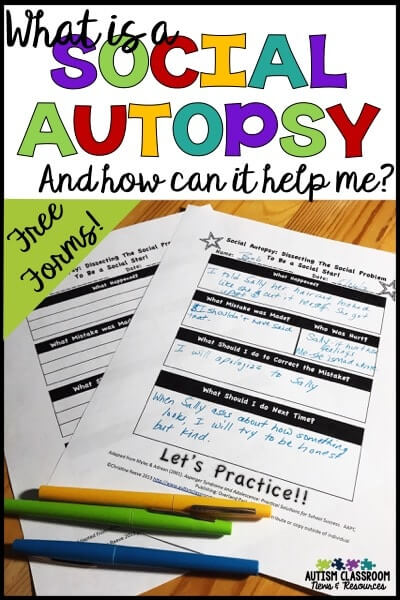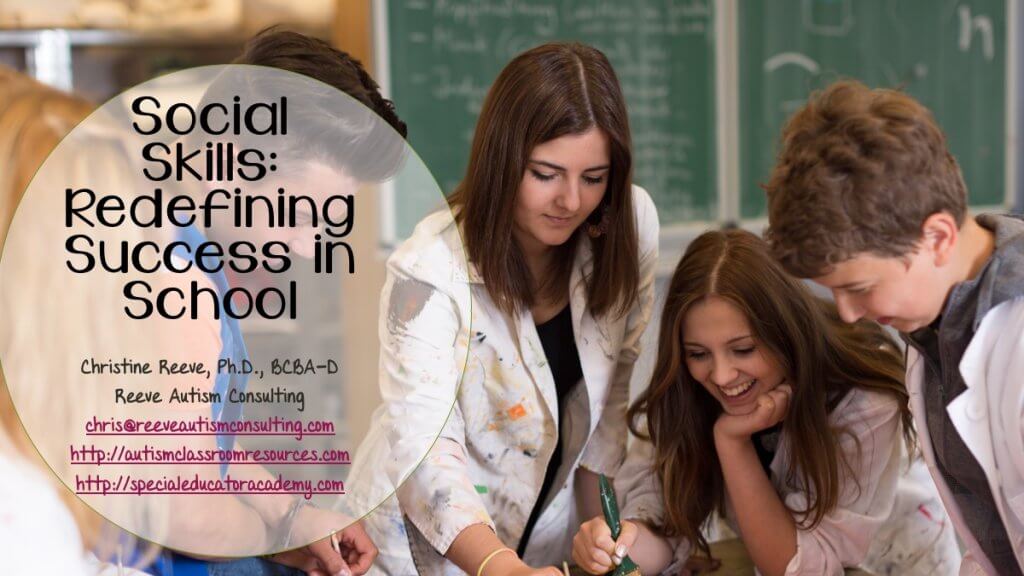Many of you may not have heard of social autopsies or you might have used a social autopsy to debrief with a student. I’ve talked about them in a limited way on this site but I wanted to delve into them a little deeper here. A social autopsy can serve double roles in a behavior support plan or in social skills instruction.
This post contains affiliate links for purchases. I only recommend resources I use myself. The price is the same to you, but it gives me a small commission to keep finding them for you.
What Is a Social Autopsy?
A social autopsy is essentially a format for helping a student dissect or take apart a social error. There are a variety of types of errors you might use it for. Brenda Myles and Diane Adreon talk about them in their book on Asperger Syndrome and Adolescence.
Simple Social Error
That error might be a simple mistake like we all make. We might call someone by the wrong name or forget someone’s birthday.
Significant Social Error
Or it might be an error that has more significant social consequences, like losing a friend or upsetting someone. For instance, when Bob tells Sally that her new haircut is terrible. Or he asks her if she cut it herself. Bob was just saying what he thinks without realizing the impact it would have on Sally.
Errors with Serious Consequences
And finally sometimes a social error is a big deal that ends up in meltdowns, tears, and sometimes more serious consequences. I’ve talked about the hidden curriculum frequently here. The difficulty many of our students have with the hidden curriculum leads to many of these social errors. In other words, they don’t know something that everyone else assumes. For instance, a high school boy who wants to know if a girl is available to chat. Instead of calling her on the phone, he goes to her house. When she doesn’t answer the door, he goes around and looks in the window. I’m thinking that her father will think this is more than a social error. And yet we know that the boy didn’t mean to seem like a stalker.

Meltdowns and Behavioral issues
And a social autopsy might be helpful when working with a student who has meltdowns (screaming, throwing things, out of control) because others aren’t conforming to his rules of the world. Ever met that kid? The kid who has to have all the lights off or the door closed? Or the one who has to correct the teacher’s grammar and gets upset if she doesn’t fix it?
In short, many of our students struggle with managing their own perspective and it often leads to behavioral issues when they try to solve the problem (and do it poorly). Social autopsies are useful at those times to help the student debrief about the situation. They help them to rethink the situation, when they are calm, and figure out where they went wrong.
How Does a Social Autopsy Work?
1. Review What Happened
Typically you want to start this process when the individual is calm. No one can think clearly in the middle of a behavioral issue, crisis, or upsetting event. For some students I do it later the same day or even just after they calm down. For others, we have to wait until the next day for him or her to be objective.
Simply go through the events that occurred, without judgment. Have the student describe what he perceived happened. You can then reframe it if need be from others’ perspectives.
2. Identify the Mistake
Next, have the student try to identify the mistake that was made. If he can’t determine it, help him. Obviously making him frustrated about it all over again isn’t the point. The mistake might be that he didn’t understand how other people would perceive his behavior. Or it might be that he said something that the other person thought was bad. A mistake isn’t about who is at fault–it’s about recognizing what happened that caused the problem.
3. Identify Who Was Hurt
It might be that everyone involved was hurt by the situation, including your student. You can talk about the impact on the student, but also talk about the impact it had on the other people involved. Talk about their perspectives of the situation. Help the student understand the different types of “hurt” (e.g., hurt feelings, actual damage, injury, damaged trust, etc.).
Sign up for the Newsletter, Get a Free Social Autopsy Form and Access to My Growing Free Resource Library!

Want more ideas for teaching social skills in the classroom? Come join the Academy and check out the Social Skills course. Grab a free 7-day free trial with the button below.
[socialpug_tweet tweet=”Social autopsies are a great way to debrief with students about anything from minor social errors to bigger behavioral issues. This post explains how I use them and you can get a free one to try! #autism #ASD” display_tweet=”Social autopsies are a great way to debrief with students about anything from minor social errors to bigger behavioral issues. This post explains how I use them and you can get a free one to try!” style=”2″]
4. Identify What To Do To Fix the Mistake
Is there something the student should do to rectify the situation? Should he / she apologize to the one who was hurt? Replace something that was broken? There may not be a way to actually repair the situation, but talking about possibly ways to make it up to someone is a good practice.
5. Identify What to do Next Time
What can be done to keep the situation from occurring again? What should the student do instead of the behavior or error he/she displayed? For instance, should the boy call the girl on the phone rather than looking in her window? Should Bob say “Your hair is nice” or “It’s OK” (for that kid who can’t bring himself to say something nice when he hates it)?
6. Role Play
This is the step that almost always gets left out. It’s not enough to talk about behavior, even social behavior. We all know how easy it is to talk and know the right thing to do. Doing the right thing is harder, but more important. Our students aren’t going to be able to use the substitute strategy identified in step 5 if they don’t practice it. And practice it over and over in most cases.
What’s the secret use of social autopsies?
In addition to serving as graphic organizers for guiding the process described above, social autopsies also can be a data collection tool. If you use one consistently after a behavioral issue that you are trying to track, they can be documentation of the type of behavior and situation in which it took place. If it has the information on it, you can use it for further assessment of problems to address. As long as it is consistently used, it can also serve to allow you to count them to get a frequency of problems. I love it when you can kill 2 birds with one stone!
If you have students who are able to think through social problems, I hope you will consider using social autopsies if you haven’t before. You can even download a free set below to try!







